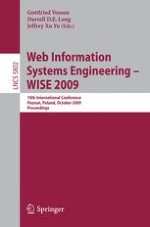Welcome to the tenth anniversary of the International Conference on Web Information Systems Engineering, WISE 2009. This year the WISE conference continued the tradition that has evolved from the inaugural conference held in 2000 in Hong Kong and since then has made its journey around the world: 2001 Kyoto (Japan), 2002 Singapore, 2003 Rome (Italy), 2004 Brisbane (Australia), 2005 New York (USA), 2006 Wuhan (China), 2007 Nancy (France), and 2008 Auckland (New Zealand). This year we were happy to hold the event in Poznan, a city of 600,000 inhabitants in western Poland. Poznan is the capital of the most affluent province of the country – Wielkopolska – which means “Greater Poland”. For more than 1,000 years, Poznan’s geographical location has predestined the city to be a significant scientific, cultural and economic center with more than just regional influence. The city is situated on the strategic cross-roads from Paris and Berlin in the west, to Warsaw and Moscow in the east, and from Scandinavia through the Baltic Sea in the north to the Balkans in the south. Poznan is a great research and university center with a dynamic potential. In all, 140,000 students are enrolled in 26 state-run and private institutions of higher education here, among which the Poznan University of Economics with its 12,000 students is one of the biggest. The WISE 2009 Conference provided a forum for engineers and scientists to present their latest findings in Web-related technologies and solutions.
